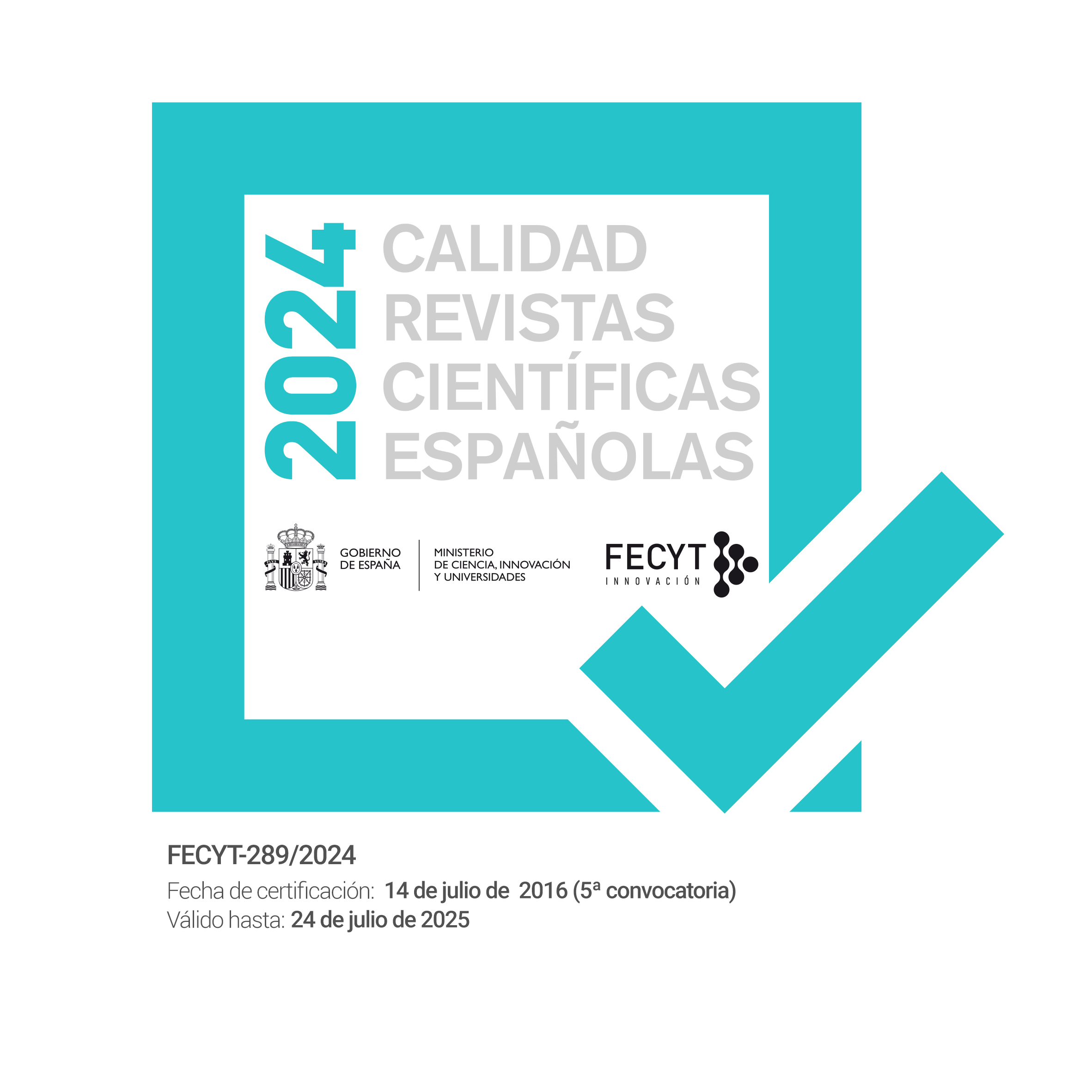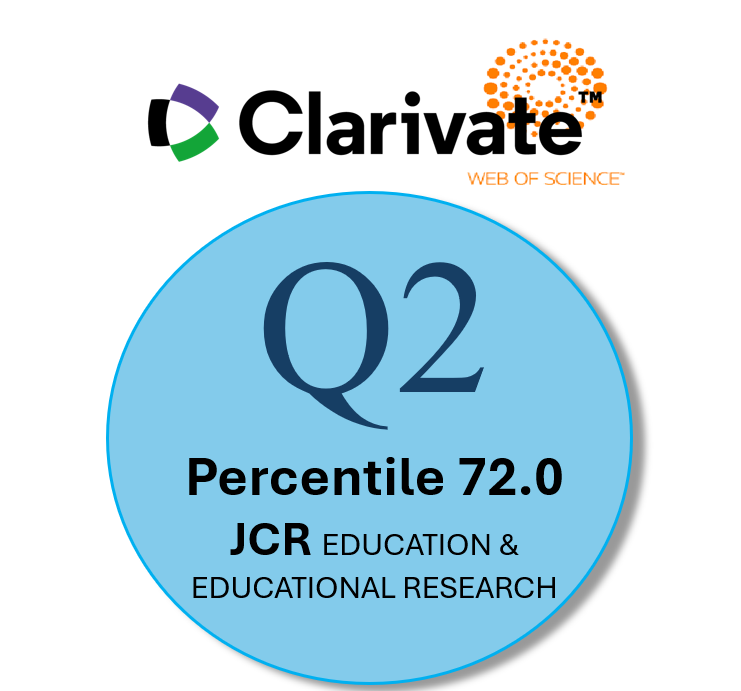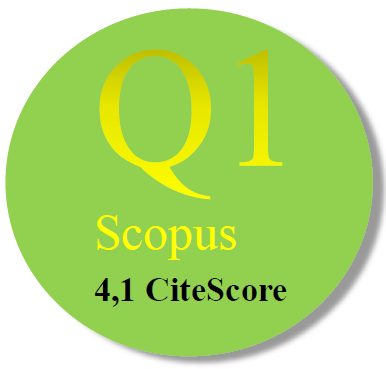Evolution of non-university digital teacher training in Spain: a comparison among different regions
Abstract
In recent decades, Information and Communication Technologies have gained significant relevance in all areas of society, including the field of education. This is due, among other reasons, to the transformative methodological potential they present and their multiple possibilities in teaching and learning processes. The presence of digital infrastructure within schools is crucial for integrating technology into them, but it is also necessary for teachers to know how to use it in a didactic and pedagogical way with students. Generally, digital training for teachers has focused more on understanding the tools and their most basic functions than on their pedagogical use within the classrooms. This study analyzes the number and themes of digital training courses offered to teachers by Spanish educational administrations, classifying them into two main areas: (i) knowledge of tools and initiation, and (ii) didactics and curricular content. The results show a change in the content of these teacher training programs over time.
Downloads
-
Abstract493
-
PDF554
References
Adarkwah, M. A. (2021). “I’m not against online teaching, but what about us?”: ICT in Ghana post Covid-19. Education and Information Technologies, 26(2), 1665–1685. https://doi.org/10.1007/s10639-020-10331-z
Aguaded, I., Marín-Gutiérrez, I., & Díaz-Parejo, E. (2015). La alfabetización mediática entre estudiantes de primaria y secundaria en Andalucía (España). Revista Iberoamericana de Educación a Distancia, 18(2), 275–298.
Alexopoulou, A., Batsou, A., & Drigas, A. S. (2019). Effectiveness of assessment, diagnostic and intervention ICT tools for children and adolescents with ADHD. International Journal of Recent Contributions from Engineering, Science & IT (iJES), 7(3), 51–63. https://doi.org/10.3991/ijes.v7i3.11178
Antonietti, C., Cattaneo, A., & Amenduni, F. (2022). Can teachers’ digital competence influence technology acceptance in vocational education? Computers in Human Behavior, 132, 107266. https://doi.org/10.1016/j.chb.2022.107266
Area, M., Alonso, C., Correa, J. M., del Moral, M. E., de Pablos, J., Paredes, J., Peirats, J., Sanabria, A. L., San Martín, A., & Valverde, J. (2014). Las políticas educativas TIC en España después del Programa Escuela 2.0: las tendencias que emergen. Revista Latinoamericana de Tecnología Educativa, 13(2), 11–33. https://doi.org/10.17398/1695-288X.13.2.11
Area, M., Sanabria, A. L., & Vega, A. M. (2013). Las políticas educativas TIC (Escuela 2.0) en las Comunidades Autónomas de España desde la visión del profesorado. Revista Científica de Tecnología Educativa, 2(1), 74–88.
Backfisch, I., Scherer, R., Siddiq, F., Lachner, A., & Scheiter, K. (2021). Teachers’ technology use for teaching: Comparing two explanatory mechanisms. Teaching and Teacher Education, 104, 103390. https://doi.org/10.1016/j.tate.2021.103390
Ballestero, C., Cabero, J., Llorente, M.C., & Morales, J.A (2010). Usos del e-learning en las universidades andaluzas. Estado de la situación y análisis de buenas prácticas. Pixel-Bit. Revista de Medios y Educación, 37, 7-18.
Bangemann, M. (1994). Informe sobre Europa y la sociedad global de la información. Boletín de La Unión Europea. Suplemento, (2), 5–40.
Barroso, J., & Cabero, J. (2013). Nuevos escenarios digitales. Pirámide
Budnyk, O., & Kotyk, M. (2020). Use of information and communication technologies in the inclusive process of educational institutions. Journal of Vasyl Stefanyk Precarpathian National University, 7(1), 15–23. https://doi.org/10.15330/jpnu.7.1.15-23
Cabero-Almenara, J. (2014). Formación del profesorado universitario en TIC. Aplicación del método Delphi para la selección de los contenidos formativos. Educación XX1, 17 (1), 1-132. https://doi.org/10.5944/educxx1.17.1.10707.
Cabero, J., & Ruiz-Palmero, J. (2018). Technologies of Information and Communication for inclusion: reformulating the “digital gap.” International Journal of Educational Research and Innovation (IJERI), 9, 16–30.
Cabero, J & Valencia, R. (2021). Y el COVID-19 transformó al sistema educativo: reflexiones y experiencias por aprender International. Journal of Educational Research and Innovation (IJERI), 15, 218-228.
Cañón, R., Grande, M., & Cantón, I. (2016). Brecha digital: Impacto en el desarrollo social y personal. Factores asociados. Tendencias Pedagógicas, 28. 115–132. https://doi.org/10.15366/tp2016.28.009
Castaño, C. (2008). La segunda brecha digital. Ediciones Cátedra.
Castro, M. D. B., & Tumibay, G. M. (2021). A literature review: efficacy of online learning courses for higher education institution using meta-analysis. Education and Information Technologies, 26(2), 1367–1385. https://doi.org/10.1007/s10639-019-10027-z
Comisión de las Comunidades Europeas. (1993). Las nuevas tecnologías de la información en la educación. https://repositori.uji.es/xmlui/bitstream/handle/10234/184030/Nuevas_tecnolog%C3%ADas_educac.pdf?sequence=1&isAllowed=y
Comisión de las Comunidades Europeas. (1995). Libro blanco sobre la educación y la formación: enseñar y aprender. Hacia la sociedad cognitiva. Oficina de Publicaciones Oficiales de las Comunidades Europeas. https://eur-lex.europa.eu/LexUriServ/LexUriServ.do?uri=COM:1995:0590:FIN:ES:PDF
Comisión Europea. (2000). eEurope: una sociedad de la información para todos. Informe de avance para el Consejo Europeo extraordinario sobre Empleo, Reforma Económica y Cohesión Social - Hacia una Europa basada en la Innovación y el Conocimiento.https://eurlex.europa.eu/legalcontent/ES/TXT/PDF/?uri=CELEX:52000DC0130&from=NL
Cook, A., & Polgar, J. (2000). Assistive technologies: principles and practice. Mosby-Year Book Inc.
Dawson, C., & Rakes, G. C. (2003). The influence of principals’ technology training on integration of technology into schools. Journal of Research on Technology in Education, 36 (1), 29–49.
Dawson, K., Cavanaugh, C., & Ritzhaupt, A. D. (2008). Florida’s EETT leveraging laptops initiative and its impact on teaching practices. Journal of Research on Technology in Education, 41(2), 143–159.
De Benito-Castanedo, J. (2017). Análisis bibliográfico sobre la brecha digital y la alfabetización en nuevas tecnologías. Revista Electrónica Educare, 21(2), 1. https://doi.org/10.15359/ree.21-2.9
Derlukiewicz, N., & Mempel-Śnieżyk, A. (2019). Information Society and E-Government in the European Union. In K. S. Soliman (Ed.), Vision 2025: Education Excellence and Management of Innovations through Sustainable Economic Competitive Advantage. Proceedings of the 34th International Business Information Management Association Conference (IBIMA) (pp. 9916–9926). International Business Information Management Association.
Diep, A., Zhu, Ch., Struyven, K y Blieck, Y. (2017). Who or what contributes to student satisfaction in different blended learning modalities? British Journal of Educational Technology, 48(2), 473– 489. https://doi.org/10.1111/bjet.1243
Emejulu, A., & McGregor, C. (2019). Towards a radical digital citizenship in digital education. Critical Studies in Education, 60(1), 131–147. https://doi.org/10.1080/17508487.2016.1234494
European Commission. (2013). Survey of Schools: ICT in Education Benchmarking Access, Use and Attitudes to Technology in Europe’s Schools. https://op.europa.eu/en/publication-detail/-/publication/ceb8a8b5-f342-4890-8323-4000e99deb3d/language-en
European Commission (2018). SELFIE, Self-reflection on Effective Learning by Fostering the use of Innovative Educational Technologies. https://education.ec.europa.eu/selfie
European Commission. (2019). 2nd Survey of Schools: ICT in Education Objective 1: Benchmark progress in ICT in schools. https://data.europa.eu/euodp/data/storage/f/20190319T084831/FinalreportObjective1-BenchmarkprogressinICTinschools.pdf
European Commission. (2020). Communication from the Commission to the European Parliament, the Council, the European Economic and Social Committee and the Committee of the Regions Digital Education Action Plan 2021-2027 Resetting education and training for the digital age. https://eur-lex.europa.eu/legal-content/EN/TXT/?uri=CELEX%3A52020DC0624
European Commission. (2023). European Commission. https://education.ec.europa.eu/es/focus-topics/digital-education/action-plan/action-9
Feijoo, C., Fernández, J., Arenal, A., Armuña, C., & Ramos, S. (2021). Educational technologies in China. https://doi.org/10.2760/604641
Fuentes, A., López, J., & Pozo, S. (2019). Análisis de la Competencia Digital Docente: Factor Clave en el Desempeño de Pedagogías Activas con Realidad Aumentada. REICE. Revista Iberoamericana Sobre Calidad, Eficacia y Cambio En Educación, 17(2), 27. https://doi.org/10.15366/reice2019.17.2.002Gobierno de Canarias. (2019). Integración de las TIC en Canarias. UCticee.
Gobierno de Canarias. (2023). Gobierno de Canarias. https://www3.gobiernodecanarias.org/medusa/ecoescuela/ate/30-anos-de-tic-en-canarias/
Gobierno de Cantabria. (s. f.). Plan educantabria. Espacio tecnológico educativo.
Gobierno de las Islas Baleares. (2022). Gobierno de las Islas Baleares. https://www.caib.es/govern/sac/fitxa.do?codi=5074264&coduo=7&lang=es
Gobierno de la Provincia de Buenos Aires. (2022). Programa Nacional Conectar Igualdad. https://abc.gob.ar/secretarias/areas/subsecretaria-de-educacion/tecnologia-educativa/tecnologia-educativa/direccion-de-tecnologia
Gobierno de Navarra. (2023). Gobierno de Navarra. https://ikasnova.digital/
González, N. (2017). Influencia del contexto en el desarrollo del conocimiento tecnológico pedagógico del contenido (TPACK) de un profesor universitario. Virtualidad. Educación y Ciencia, 8(14), 42-55.
González-Pérez, L.-I., Ramírez Montoya, M. S., & García-Peñalvo, F. J. (2022). Habilitadores tecnológicos 4.0 para impulsar la educación abierta: aportaciones para las recomendaciones de la UNESCO. RIED-Revista Iberoamericana de Educación a Distancia, 25(2). https://doi.org/10.5944/ried.25.2.33088
Goktas, Y., Yildirim, Z., & Yildirim, S. (2008). A review of ICT related courses in pre-service teacher education programs. Asia Pacific Education Review, 9(2), 168–179. https://doi.org/10.1007/BF03026497
Government of Maine. (2023). The Maine Learning Technology Initiative 2.0. https://www.maine.gov/doe/Learning/LTT/MLTI/2.0#
Gros, B., Sánchez, J. A., García, I., & Alonso, C. (2020). Cuatro décadas de políticas para integrar las tecnologías digitales en el aula en Cataluña: acciones, logros y fracasos. Digital Education Review, 37.
Gulek, J. C., & Demirtas, H. (2005). Learning with technology: the impact of laptop use on student achievement. ERS Spectrum, 23(4), 4–20.
Hayes, J., & Greaves, T. (2008). America’s digital schools 2008: The six trends to watch. Encinitas, CA: The Greaves Group, The Hayes Connection.
Hermans, R., Tondeur, J., Van Braak, J., & Valcke, M. (2008). The impact of primary school teachers’ educational beliefs on the classroom use of computers. Computers & Education, 51(4), 1499–1509.
Instituto Nacional De Tecnologías Educativas De Formación Del Profesorado -INTEF. (2017). Una breve historia de las TIC Educativas en España
ISTE. (2016). National Educational Technology Standards for Students (NETS-S). https://www.iste.org/standards/standards/for-students-2016#startstandards
Jara, I. (2015). Cuaderno SITEAL Infraestructura Digital para Educación: Avances y Desafíos para Latinoamérica.
Junta de Andalucía. (2023). Junta de Andalucía. https://www.juntadeandalucia.es/educacion/portals/web/ced/planesyprogramas/programa-de-digitalizacion-de-centro
Junta de Extremadura. (2022). Junta de Extremadura. https://www.educarex.es/edutecnologias/plan-comunidad-educativa.html
Kampylis, P., Punie, Y. Y Devine, J. (2015). Promoción de un Aprendizaje Eficaz en la Era Digital – Un Marco Europeo para Organizaciones Educativas Digitalmente Competentes. https://doi.org/10.2791/54070
König, J., Jäger-Biela, D. J., & Glutsch, N. (2020). Adapting to online teaching during COVID-19 school closure: teacher education and teacher competence effects among early career teachers in Germany. European Journal of Teacher Education, 43(4), 608–622. https://doi.org/10.1080/02619768.2020.1809650
Kozma, R. B. (2008). Comparative Analysis of Policies for ICT in Education. In J. Voogt & G. Knezek (Eds.), International Handbook of Information Technology in Primary and Secondary Education (pp. 1083–1096). Springer US. https://doi.org/10.1007/978-0-387-73315-9_68
Krumsvik, R. J. (2007). Skulen og den digitale læringsrevolusjon [The school and the digital learning revolution; in Norwegian]. Universitetsforlaget.
Krumsvik, R. (2011). Digital competence in Norwegian teacher education and schools. Högre utbildning, 1(1), 39-51. https://bit.ly/3uv3ayt
Lei, J., & Zhao, Y. (2008). One-to-one computing: what does it bring to schools? Journal of Educational Computing Research, 39(2), 97–122.
Lerendegui, J. (n.d.). Las TIC en la educación aragonesa: del programa Pizarra Digital a Escuela2.0.http://aragoneduca.museopedagogicodearagon.com/content/files/magazine4_08_lasticenlaeducacion-2.pdf
Li, Q., & Ma, X. (2010). A Meta-analysis of the Effects of Computer Technology on School Students’ Mathematics Learning. Educational Psychology Review, 22(3), 215–243. https://doi.org/10.1007/s10648-010-9125-8
Liu, Q., Geertshuis, S., & Grainger, R. (2020). Understanding academics’ adoption of learning technologies: A systematic review. Computers & Education, 151, 103857. https://doi.org/10.1016/j.compedu.2020.103857
Lowther, D. L., Inan, F. A., Strahl, J. D., & Ross, S. M. (2008). Does technology integration “work” when key barriers are removed? Educational Media International, 45(3), 195–213.
Lowther, D. L., Ross, S. M., & Morrison, G. M. (2003). When each one has one: the influences on teaching strategies and student achievement of using laptops in the classroom. Educational Technology Research & Development, 51(3), 23–44.
Mendoza-González, A., Luna-García, H., Mendoza-González, R., Gamboa-Rosales, H., & Arceo-Olague, J. (2019). A strategy based in ICT for inclusion of a student with multiple disability into regular education: A case of educational rehabilitation. In Proceedings of the 5th Workshop on ICTs for improving Patients Rehabilitation Research Techniques, pp. 101–105.
Ministerio de Educación. (2009). TALIS (OCDE) Estudio Internacional sobre la Enseñanza y el Aprendizaje Informe Español.
Ministerio de Educación. (2019). TALIS 2018 Estudio internacional de la enseñanza y del aprendizaje Informe español.
Mishra, P. & Koehler, M.J. (2006). Technological pedagogical content knowledge: A framework for teacher knowledge. The Teachers College Record, 108(6), 1017- 1054. https://doi.org/10.1111/j.1467-9620.2006.00684.x
Murphy, D., King, F., & Brown, S. (2007). Laptop initiative impact: assessed using student, parent and teacher data. Computers in the Schools, 24(1/2), 57–73.
Palacios Rodríguez, A., Cabero-Almenara, J., & Barroso-Osuna, J. (2023). Competencia Digital Docente según #DigCompEdu. Aportes desde la investigación. Universidad de Sevilla.
Penuel, W. R. (2006). Implementation and effects of one-to-one computing initiatives: a research synthesis. Journal of Research on Technology in Education, 38(3), 329–348.
Puentedura, R. (2013). SAMR: Getting To Transformation. http://www.hippasus.com/rrpweblog/archives/2013/04/16/SAMRGettingToTransformati on.pdf
Redecker, C., & Punie, Y. (2017). European Framework for the Digital Competence of Educators: DigCompEdu.
Rivoir, A. (2020). Revisión de antecedentes sobre One Laptop Per Child y discusión sobre sus resultados en América Latina. En: Tecnologías digitales y transformaciones sociales. CLACSO.
Rodríguez-Carracedo, M. y De-La-Barrera-Minervini, J. (2014). Technological literacy for seniors. Experience in the UNED Senior, Argentina. Virtualidad, Educación y Ciencia, 5(9), 56–69.
Rutledge, D., Duran, J., & Carroll-Miranda, J. (2007). Three years of the New Mexico laptop learning initiative (NMLLI): stumbling toward innovation. AACE Journal, 15(4), 339–366.
Sailer, M., Stadler, M., Schultz-Pernice, F., Franke, U., Schöffmann, C., Paniotova, V., Husagic, L., & Fischer, F. (2021). Technology-related teaching skills and attitudes: Validation of a scenario-based self-assessment instrument for teachers. Computers in Human Behavior, 115, 106625. https://doi.org/10.1016/j.chb.2020.106625
Sánchez-Antolín, P., & Paredes, J. (2014). La concreción de las políticas educativas de integración de las TIC europeas y españolas en la Comunidad de Madrid. Teoría de La Educación. Educación y Cultura En La Sociedad de La Información., 15(4), 1–289.
Scherer, R., Howard, S. K., Tondeur, J., & Siddiq, F. (2021). Profiling teachers’ readiness for online teaching and learning in higher education: Who’s ready? Computers in Human Behavior, 118, 106675. https://doi.org/10.1016/j.chb.2020.106675
Sivin-Kachala, J., & Bialo, E. (2000). 2000 Research report on the effectiveness of technology in schools. Washington, DC: Software and Information Industry Association.
Soomro, K. A., Kale, U., Curtis, R., Akcaoglu, M., & Bernstein, M. (2020). Digital divide among higher education faculty. International Journal of Educational Technology in Higher Education, 17(1), 21. https://doi.org/10.1186/s41239-020-00191-5
Suriá, M. (2011). Percepción del profesorado sobre su capacitación en el uso de las TIC como instrumento de apoyo para la integración del alumnado con discapacidad. Profesorado. Revista de Currículum y Formación Del Profesorado., 15(2).
The Abell Foundation. (2008). One-to-one computing in public schools: Lessons from “laptops for all” programs. Baltimore, MD: Author.
UNESCO. (2005). Informe Mundial de la UNESCO. Hacia las sociedades del conocimiento.
UNESCO. (2014). Aprovechar el Potencial de las TIC para la Alfabetización.
UNESCO. (2020). Global Education Monitoring Report 2020: Inclusion and education: All Means All. UNESCO. https://doi.org/10.54676/WWUU8391
UNESCO, European Commission, & Grupo Comunicar. (2009). Mapping Media Education Policies in the World: Visions, Programmes and Challenges. (D. Frau-Meigs & J. Torrent (Eds.)). UNESCO, Grupo Comunicar.
U.S. Department of Education. (2017). Reimagining the Role of Technology in Education: 2017 National Education Technology Plan Update. U.S. Department of Education, May 8. https://tech.ed.gov/files/2017/01/NETP17.pdf
Valerio, C. y Paredes, J. (2008). Evaluación del uso y manejo de las tecnologías de información y comunicación en los docentes universitarios. Un caso mexicano. Revista Latinoamericana de Tecnología Educativa, 7(1), 13-32.
Van der Spoel, I., Noroozi, O., Schuurink, E., & van Ginkel, S. (2020). Teachers’ online teaching expectations and experiences during the Covid19-pandemic in the Netherlands. European Journal of Teacher Education, 43(4), 623–638. https://doi.org/10.1080/02619768.2020.1821185
Van Dijk, J. (2017). Digital divide: Impact of access. In P. Rössler, C. A. Hoffner, & L. Van Zoonen (Eds.), Digital divide: Impact of access. (pp. 1–11). John Wiley y Sons.
Wachira, P., & Keengwe, J. (2011). Technology integration barriers: Urban school mathematics teachers perspectives. Journal of science education and technology, 20, 17-25.
Williamson, B., Potter, J., & Eynon, R. (2019). New research problems and agendas in learning, media and technology: the editors’ wishlist. Learning, Media and Technology, 44(2), 87-91. https://doi.org/10.1080/17439884.2019.1614953
Zheng, B., Warschauer, M., Lin, C.-H., & Chang, C. (2016). Learning in One-to-One Laptop Environments. Review of Educational Research, 86(4), 1052–1084. https://doi.org/10.3102/0034654316628645
Zucker, A. (2004). Developing a research agenda for ubiquitous computing in schools. Journal of Educational Computing Research, 30(4), 371–386.
Zucker, A., & Hug, S. (2008). Teaching and learning physics in a 1:1 laptop school. Journal of Science Education and Technology, 17(6), 586–594.
Copyright (c) 2024 Distance Education Journal

This work is licensed under a Creative Commons Attribution-NonCommercial 4.0 International License.
Las obras que se publican en esta revista están sujetas a los siguientes términos:
1. El Servicio de Publicaciones de la Universidad de Murcia (la editorial) conserva los derechos patrimoniales (copyright) de las obras publicadas, y favorece y permite la reutilización de las mismas bajo la licencia de uso indicada en el punto 2.
2. Las obras se publican en la edición electrónica de la revista bajo una licencia Creative Commons Reconocimiento-NoComercial-SinObraDerivada 3.0 España (texto legal). Se pueden copiar, usar, difundir, transmitir y exponer públicamente, siempre que: i) se cite la autoría y la fuente original de su publicación (revista, editorial y URL de la obra); ii) no se usen para fines comerciales; iii) se mencione la existencia y especificaciones de esta licencia de uso.
3. Condiciones de auto-archivo. Se permite y se anima a los autores a difundir electrónicamente las versiones pre-print (versión antes de ser evaluada) y/o post-print (versión evaluada y aceptada para su publicación) de sus obras antes de su publicación, ya que favorece su circulación y difusión más temprana y con ello un posible aumento en su citación y alcance entre la comunidad académica. Color RoMEO: verde.













